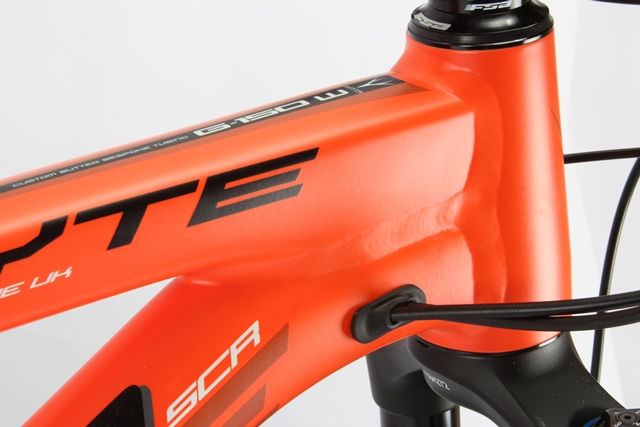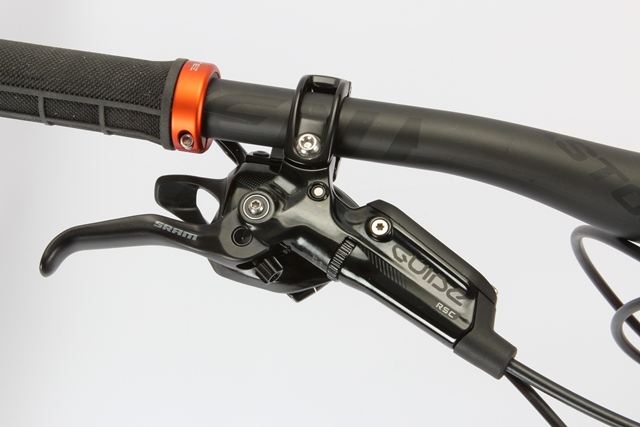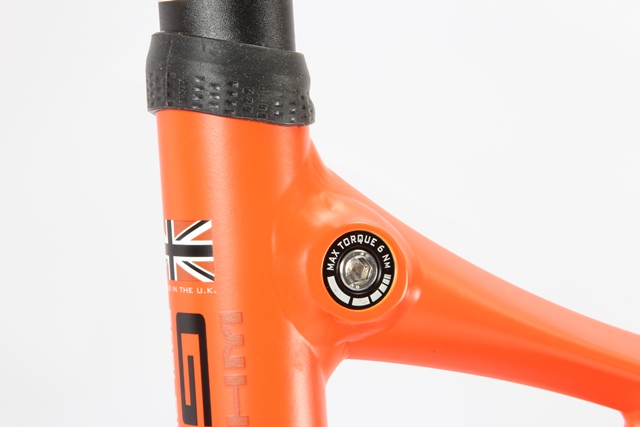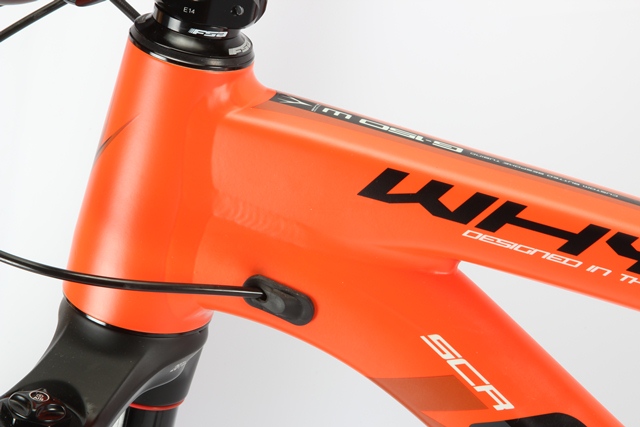Whyte G-150 Works
Made for riders who like to get rough and rowdy, the G-150 is one of the newest offerings from UK brand Whyte Bikes.
Regular readers will probably be aware that whilst I have an overarching dislike of white bikes, I’m generally a fan of Whyte bikes. The UK company was a relatively early proponent of the now ubiquitous long, low and raked-out front end geometry combined with short chainstays. The latest addition to their relatively compact range is the G-150, with (you guessed it) 150mm of travel at both ends.
This model is built as an all-out gravity enduro monster truck; indeed Whyte’s factory rider Martyn Brookes piloted one to 3rd place at the French Megavalanche event in 2014. It comes in just three sizes (small, medium and large) and there are only two spec levels available; the G-150S for $5,299 and the G-150 Works tested here for $7,599.
Eschewing the black plastic of most high-end bikes, both models use a custom designed and drawn 6061 aluminium frame. With the RockShox Monarch Plus Debonair shock fitted, our medium frame tipped the scales at 3,680g. That’s pretty hefty, so the overall weight of 13.2kg without pedals is quite impressive.
The healthy package weight comes thanks to the premium level parts that feature throughout. It starts with a full SRAM X01 drivetrain and the new Guide RSC brakes; both great performers that also keep the weight down. You’ll also find a light but strong 35mm Easton Haven Carbon bar and stem combo.
It needs to be said that the G-150 is not a cheap bike by any stretch; a similar spec’d aluminium bike from one of the larger mainstream brands would probably save you between $1,000 and $2,000. Small, boutique brands like Whyte will always be at a price disadvantage compared to those who make bikes by the thousands, or even tens of thousands. Their value is in their uniqueness, and often in the little details that show a real passion for making each bike the best it can possibly be.
Whilst the frame material itself may seem a bit ordinary, there are a whole host of design features which clearly demonstrate that Whyte have really sweated the details on the G-150. First up is a set of crud-catcher bosses under the downtube, which anyone who regularly rides in muddy conditions will greatly appreciate (Whyte are from the UK after all). The cable routing is mostly internal for a tidy finish but most importantly it’s well executed. They use a full length outer housing (another mud-proof feature) with rubber grommets where it enters the frame. These grommets serve the dual task of securing the cables and keeping muck out— they haven’t budged a millimetre in the time we’ve had the bike, which is more than we can say for many other attempts at internal cable routing.
Also keeping the frame’s innards clean is the slot-free internal seatpost clamp, complete with a rubber boot to stop your dropper post from seizing into the frame (when was the last time you moved your dropper post?). Whilst on the RockShox Reverb post, Whyte is one of the few companies that puts the remote where I think it belongs; under the bar on the left side. A small water bottle will fit inside the front triangle and the inclusion of ISCG tabs mean you can run a chainguide if you wish.
Mechanics around the world will rejoice the easy-to-service threaded bottom bracket, as well as trunion nuts in the rear brake mount—these make repairs easy if someone gets overenthusiastic with the allen key. Whyte also offers a lifetime replacement warranty on all of the suspension pivot bearings. Speaking of the finish, whilst the safety-orange colour scheme is certainly bright, the matte paint looks a lot classier and has held up better than the gloss used on many bikes these days.
One thing conspicuous by its absence is a front derailleur; the G-150 has no provision for front shifting and there’s no way to bodge one up either. Freeing up the real estate traditionally reserved for a front mech has allowed Whyte to shorten the chainstays to just 425mm. You’ll also notice that both chainstays are completely straight—the driveside stay doesn’t drop down in an arc like most. This Symmetrical Chain Stay (SCS) design aims to make the back end stiffer for its weight; expect to see more of this idea as riders continue to embrace 1X drivetrains.
The Quad-Link Four suspension, which is Whyte’s take on the Horst Link, drives the shock via a short yoke that wraps around the seat tube. The idea of using a shock yoke to get around that pesky seat tube isn’t new, but instead of using a modified and proprietary shock shaft to fit the yoke, the G-150 uses a standard shock. The yoke bolts straight through the eye that would normally hold the DU bushing and so far this setup has been silent and hassle free.
G WHIZZ
Silent is the key word; hitting the trails on the G-150 is like going into some sort of sensory anomaly where all you can hear is the squishing of suspension and the rip of tyres on dirt. If quiet bikes always feel fast, then the G-150 feels like you’re flying—there’s zero chain slap, no cable rattle and even the freehub is as silent as the grave. The G-150’s Quad Link Four suspension favours traction and suppleness over outright pedalling efficiency. It glues the tyres to the trail whilst simultaneously absorbing even the smallest ripple or tiniest rock, which adds further to the magic carpet-like flying sensation. There’s very little pedal feedback when cranking through or over obstacles, and like all good Horst Link bikes, the G-150’s suspension manages to stay predictable and neutral under brakes, even in the rough.
Whether climbing or descending, the distinct linearity of the suspension is instantly noticeable. Combined with inherently low levels of anti-squat and 25-30% sag, I found the shock’s open setting to allow a little too much rider-induced bob for sustained pedalling. Because of this I usually chose to run the middle compression setting on the Monarch Plus Debonair shock; this dramatically reduced unwanted movement without significantly muting the bump absorption. The added bonus was better support when pumping the G-150 through compressions, hitting drops or ploughing through rock gardens.
Even in the middle setting I regularly slammed the travel indicator to the stops, but I not once felt a harsh sense of bottoming the suspension. Whyte’s leverage ratio combines with the inherent spring curve of the air shock to produce one of the most consistently linear suspension setups that you’re likely to come across.
With such supple and ground hugging suspension the G-150 will clamber its way up silly rough or steep climbs if you can keep your weight centred, although you can expect plenty of rock strikes. I measured the bottom bracket height at around 328mm (Whyte lists it as 343mm)—that’s about as low as you can get in this travel category. Whilst it adds bucket loads of slice and dice cornering stability, your crank ends will pay the price on technical climbs.
Heavier riders or those who ride hard might feel there’s a slight lack of mid-stroke support and not enough ramp-up – something that should be resolved by an air can spacer or two – but for most the external compression adjustment on the shock will provide enough tinkering range to keep the G-150 moving when you want it and steady went you don’t. And my-oh-my, the Monarch Plus shock with its new Debonair air can is a lovely creature! Unless you’ve been living under a rock for two years, you’ll know that the RockShox Pike is rated by many as the best mid-travel fork on the market. Now this variant of the Monarch shock is rapidly becoming the top contender for rear suspension as well.
Testing the G-150 was the first time I’d encountered the new SRAM Guide brakes; having experienced mixed reliability with previous SRAM models I felt somewhat ambivalent about their presence. I’ll admit that I was wrong; the Guides have not only performed flawlessly and silently, but their modulation is absolutely brilliant. As a long-time fan of Shimano brakes, I have to say that these will sorely test my loyalties. The stubby new lever felt smoother than XTR and they offered better fine control at the edge of traction, without giving anything away to the competition in all-out power. Seems the brake battle is truly on!
Parts wise there was little to complain about on the fully SRAM’d out G-150; in addition to the excellent stoppers, the Reverb Stealth post with its ‘correctly’ mounted remote ran smoothly and reliably, and the X01 11-speed drivetrain didn’t drop the chain or miss a beat, despite the lack of any chainguide. Given the low bottom bracket height and ensuing number of pedal strikes, perhaps spec’ing the aluminium version of the cranks would have been a wise choice, but the carbon certainly adds some bling value and sheds a little weight.
I will say that the 18-tooth freewheel ratchet that comes standard with the SRAM wheels is woefully slow to engage; why these wheels didn’t run the 36-tooth option is a mystery as confounding as the Bermuda triangle. Whilst on the topic of the SRAM wheels, the set on our test bike, like the few other pairs we’ve encountered over the last year, have been utterly bombproof; it’s just a shame that they’re comparatively narrow (23mm internal). Most manufacturers have now realised that wider rims (25- 35mm internal) allow the use of much lower tyre pressures without sacrificing stability or tyre security, and this leads to vastly improved traction in all situations. Fortunately, the super grippy, if a little slow, High Roller II tyres have a very square profile which works well on narrower rims. This wheel and tyre combination held air and performed admirably for the entire test.
GEE UP
Bikes of this type get propelled into a variety of tasks; some will use them as an everyday, do everything trail bike where climbing ability is quite important. In other cases descending capability will be the overriding force and it may serve as a dedicated gravity enduro bike. One of the surprises with the G-150 is that Whyte, despite being early exponents of the slack head angle, have kept the front end at 66.5-degrees; that’s relatively conservative for an enduro bike. It feels slacker than you might think – perhaps because the bottom bracket is so low and the back end so short – but given the pedalling related ground clearance issues, I think it’d be wise to set the Pike up with 160mm of travel. This simple and relatively low-cost modification would raise the bottom bracket by a few millimetres and drop half a degree off the head angle; the result being increased stability at speed and a bit of extra breathing space under the cranks. That said, it’s a very well balanced and seriously fun bike. There’s virtually no learning curve and from the moment you swing a leg over the G-150 you feel comfortable and in control.
The frame and fork are stiff enough to go exactly where you put them, and those extra short chainstays make sliding the back end through turns or lofting the front wheel a breeze. It’s like a slalom skier in the corners and a mogul skier in the rough; the supple suspension and planted feel will slingshot you out of corners and pump for speed over every bump in the trail. Instead of focusing on every little ripple and lump, you can get on with the bigger task of how to extract more speed from both the pedals and the terrain. The G-150 also hides its weight well; it’s one of those bikes that handles and rides much lighter than the scales would have you believe. It’ll probably suit a rider who’s focused primarily on descending more than one who places even emphasis on both the ups and the downs, but there’s really nothing it can’t do well save outright mile munching.
I’m going to be a bit sad when I have to say goodbye to the G-150. There’s no shortage of great mountain bikes out there today and the Whyte is certainly one of them. Whether you’re looking at the G-150 Works or lower spec’d S version, it’s relatively expensive for an alloy dually and it’ll be wasted on tamer trails, but it has a forgiving and engaging ride quality that’s hard not to love. Whyte’s attention to detail and design is both noteworthy and likely to contribute to greater longevity with less maintenance. It’s an eye-catching and unique bike with the chops to back up its looks, and all things considered, the G-150 is simply more proof that I really like Whyte bikes; even if they’re bright orange.
Thumbs Up
• Smooth yet lively ride with modern geometry
• Excellent attention to the detail
• Spec’d just how you’d want to ride it
Thumbs Down
• Price
• Frame isn’t the lightest
• Bottom bracket may be too low for some
Specifications
Frame: 6061 T6 Alloy
Shock: RockShox Monarch Plus Debonair RC3, 150mm Travel
Fork: RockShox Pike RCT3 150mm travel
Headset: FSA Integrated
Handlebars: Easton Haven Carbon 35, 750mm
Stem: Easton Haven 35, 50mm
Shifter: SRAM X01
Front Derailleur: N/A
Rear Derailleur: SRAM X01
Cassette: SRAM X01, 10/42 11-speed
Chain: SRAM X01
Cranks: SRAM X01
Bottom Bracket: SRAM Threaded GXP
Pedals: N/A
Brakes: SRAM Guide RSC
Wheels: SRAM Rail
Tyres: Maxxis High Roller II TR 2.3
Saddle: Fizik Gobi
Seatpost: RockShox Reverb Stealth
Weight: 13.2kg without pedals (medium frame 3,680g)
Available Sizes: S, M (tested) & L
Price: $7,599
Distributor : Carbuta Pty Ltd 0439 902 770 www.whyte.bike/gb















